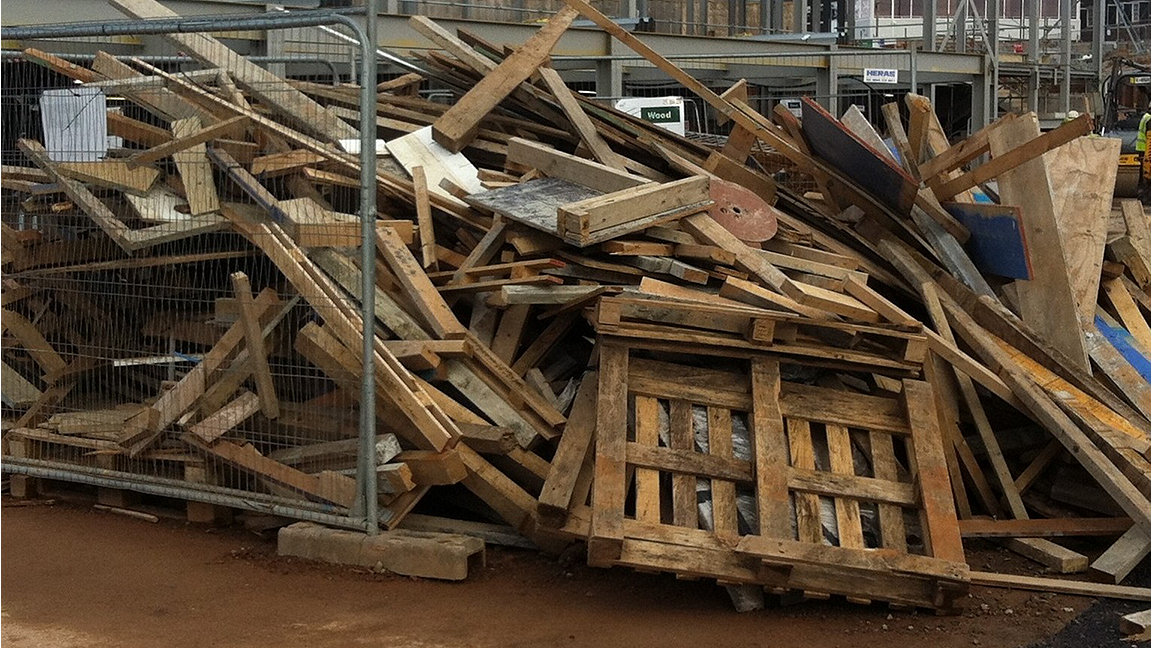
© Charles Law
The Environment Agency (EA) recently published interim regulatory position statement (RPS) 291 requires those who produce certain timber waste to check that it meets hazardous waste thresholds, and submit this data to the Wood Recyclers' Association (WRA). As a consequence, waste producers will need to understand their new responsibilities.
Under the previous statement, RPS 250 – which the EA recently withdrew – both non-hazardous and potentially hazardous waste wood could be received at waste transfer stations before being processed and sent mixed for recovery into panel board or certain kinds of biomass. Now, however, certain wood components will need to be tested before it is sent on.
Although the environmental regulators in Scotland, Wales and Northern Ireland have not published new positions, they are supporting all the WRA guidance so the same principles will apply in these nations.
Potentially hazardous treatments require investigation
The Construction (Design and Management) Regulations 2015 state that the client has a legal obligation to inform the designer and principal contractor of any hazards that may be present on site.
From the 1950s until 2007, a number of hazardous substances were used to preserve softwood timber components in use classes 2 to 4; specifically, components such as building timbers at risk of insect attack or wetting, including condensation, and external timbers that were above ground or in contact with it.
Treatments included heavy metals, such as copper compounds, arsenic, tributyltin oxides and chromium, along with other chemicals. These would have been pressure-impregnated into the timbers in various concentrations.
Such heavy metals and chemicals may render the timber element hazardous, if found in concentrations above levels prescribed in the UK government's Technical Guidance WM3: Waste Classification – Guidance on the classification and assessment of waste.
This means that before any work can be carried out on a building constructed or refurbished between 1950 and 2007, you must perform a detailed survey of the timber elements to identify components that could be deemed hazardous and, wherever possible, test them to confirm whether they are hazardous or not.
Guidance specifies components for consideration
The Chartered Institution of Wastes Management (CIWM) Construction, Demolition and Excavation Technical Advisory Group has therefore published guidance with the support of the EA and the WRA. Waste Wood Assessment Guidance version 1.3 is designed to ensure the construction and demolition sectors manage such waste correctly.
The document identifies a number of softwood components that will be deemed hazardous depending on their date of installation, unless independent laboratory test evidence confirms otherwise.
These currently comprise the following:
- structural timber frame parts such as sole and head plates, studs and floor joists – including strutting – installed between 1950 and 2007
- roof timbers, including roof trusses, pitched-roof rafters, purlins, ceiling joists, flat roof joists, firring pieces and upstands installed between 1950 and 2007
- tiling and cladding battens, including roof tiling battens, sarking boarding and cladding battens installed between 1950 and 2007
- external doors and door frames, including sills and glazing beads, installed between 1950 and 1995
- windows and window frames, including casement or sash window frames, sills and glazing beads installed between 1950 and 1995
- soffits, fascias and barge boards installed between 1950 and 1995
- cladding installed between 1950 and 1995
- external fencing, including posts, rails and boards installed before 2007
- decking, including framing and posts installed before 2007.
These items are all subject to an ongoing testing project by the EA, WRA and the wider industry, so you should clarify at the time of demolition whether items have been added to or removed from the list.
The guidance also identifies timbers that are deemed hazardous, regardless of the year of installation; again, unless independent laboratory test evidence confirms otherwise. These currently comprise all of the following:
- railway sleepers
- telegraph poles
- timber from heavy industrial sites, including cooling towers and hydraulic engineering sites such as docks.
Assessment processes set out
The guidance contains two flow charts that you should follow when surveying a building due to be refurbished or demolished, so you can assess each timber component and identify testing requirements.
Even though the timber may be deemed non-hazardous given the date of installation, you must also check by sight and smell for other hazardous contaminants and subsequently applied treatments – for example, creosote – before deeming any waste wood non-hazardous.
You must also clearly identify the locations of all timbers identified as potentially hazardous in this way in the final building survey report, and recommend these be tested to confirm whether or not they are indeed hazardous.
'You must also check by sight and smell for other hazardous contaminants and subsequently applied treatments'
Hazards must be confirmed independently
Where timbers are deemed hazardous, independent testing will need to be carried out at a UKAS-accredited laboratory with suitable experience; WRA member laboratories are more familiar with the tests required, and a list of these can be found in appendix 3 of the CIWM guidance.
This testing will confirm whether the waste wood is below the WM3 threshold levels and can be classified as non-hazardous.
For most projects, only one of each component type will need to be tested. Multiple tests are not needed of the same wood type, provided the wood was all installed or treated at the same time.
Where you suspect that wood was added at a different time during defined dates – such as during a refurbishment – then one of each component from the refurbished area must also be tested.
Different components from the same project must be tested individually. Samples must be taken from a complete cross-section of the wood because treatment concentrations vary considerably from the surface to the centre, and likewise from a central portion of the component rather than the ends.
Each should be a minimum of 200g, meaning they are normally around 150mm in length, to ensure enough material can be prepared by for testing by the laboratory.
If you are arranging the testing of the samples, you will thus need to check with the laboratory for the minimum size required. You will also need to follow its advice to ensure the samples meet the legal duty of care requirements when transporting them.
These may include using a registered waste carrier or specific courier services; each laboratory will be able to explain the process agreed with its regulator.
The requirement for a whole cross-section of the timber element will pose challenges if the building is in use. If you are responsible, you will therefore need to arrange for components to be tested as soon as practically possible after decanting the occupants.
Testing looks for particular materials
Each sample will need to be tested for:
- all metals, including arsenic, copper, chromium, zinc, lead and tin
- dieldrin
- lindane
- permethrin
- pentachlorophenol.
WRA member laboratories should be asked to carry out test suite WRA02, which covers all the above substances.
As testing only picks up the concentration of heavy metals rather than what form they are in, when tin is confirmed as being more than 25mg/kg it should be considered to be in the form of tributyltin.
Therefore, a separate test is required to identify whether the tributyltin oxide or tributyltin naphthenate meets the hazardous waste thresholds.
Where contamination from other hazardous substances is suspected, additional tests will need to be agreed with the chosen laboratory; for example, analysis of total petroleum hydrocarbons for oil-based substances such as creosote.
Once the laboratory has the test results, it then needs to assess these in accordance with WM3 to determine whether the sample is hazardous or non-hazardous.
You must give the laboratory permission to share all test results anonymously with the WRA on HazWasteOnline. This enables the construction and demolition industry to compare the results from various components, and possibly enable a component type to be removed from the potentially hazardous category in future revisions of the CIWM guidance.
Understanding the revised process
The withdrawal of RPS 250 and temporary implementation of RPS 291 significantly changes the way we carry out building surveys and the treatment of waste wood.
The following processes are therefore all now necessary:
- carrying out a detailed survey of the timber elements in a building to identify the components that could be deemed hazardous
- identifying details of such components and their location in the survey report
- explaining to the client what testing is required to confirm whether these components are hazardous or non-hazardous
- submitting test results to the WRA for comparison with other results.
By providing this information, you will help the client meet its legal obligations under The Construction (Design and Management) Regulations 2015 to provide information to the designer and principal contractor of any hazards that may be present.
You will also help the industry understand which timber components are actually likely to be hazardous.
Charles Law is sustainability director at Timber Development UK, and founder and managing director of Sustainable Construction Solutions
Contact Charles: Email
Related competencies include: Inspection, Legal/regulatory compliance, Maintenance management
Enabling RICS SME members to thrive
At RICS, we want our SME members to flourish. Our SME Business Support Hub is a great place to start finding out more.
Whether an experienced or start-up SME, you'll find tailored support and resources, such as:
- guidance on business models
- statutory requirements
- insurance
- financial management
- marketing and promotion
- practical advice on aspects of buying, selling or leasing property.
We also send a monthly SME newsletter, sharing relevant support, insight and knowledge. You can sign up for this by emailing RICS directly.
Our quarterly UK Economy and property market update is also designed with SMEs in mind, providing the kind of detailed analysis and insight that may otherwise be out of reach. We conduct regular webinars as well, to take members through the latest updates and provide a forum for their questions.

